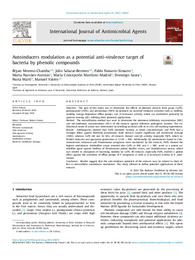Por favor, use este identificador para citar o enlazar este ítem:
https://hdl.handle.net/11000/35901Registro completo de metadatos
| Campo DC | Valor | Lengua/Idioma |
|---|---|---|
| dc.contributor.author | MARTÍNEZ-MADRID, MARIA CONCEPCIÓN | - |
| dc.contributor.author | Moreno Chamba, Bryan Mauricio | - |
| dc.contributor.author | Salazar, Julio | - |
| dc.contributor.author | Navarro Simarro, Pablo | - |
| dc.contributor.author | Narvaez-Asensio, Marta | - |
| dc.contributor.author | Saura, Domingo | - |
| dc.contributor.author | Martí, Nuria | - |
| dc.contributor.author | Valero, Manuel | - |
| dc.contributor.other | Departamentos de la UMH::Agroquímica y Medio Ambiente | es_ES |
| dc.date.accessioned | 2025-03-10T16:57:44Z | - |
| dc.date.available | 2025-03-10T16:57:44Z | - |
| dc.date.created | 2023-07 | - |
| dc.identifier.citation | International Journal of Antimicrobial Agents Volume 62, Issue 4, October 2023, 106937 | es_ES |
| dc.identifier.issn | 1872-7913 | - |
| dc.identifier.issn | 0924-8579 | - |
| dc.identifier.uri | https://hdl.handle.net/11000/35901 | - |
| dc.description.abstract | Objective: The goal of this study was to determine the effects of phenolic extracts from grape (GrPE), pomegranate (PoPE), and persimmon (PePE) by-products on bacterial virulence activities such as biofilms, motility, energy-dependent efflux pumps, and β-lactamase activity, which are modulated primarily by quorum sensing (QS), defining their potential applications. Method: The microdilution method was used to determine the minimum inhibitory concentration (MIC) and sub-inhibitory concentrations (SICs) of the extracts against reference pathogenic bacteria. The an- tibacterial mode of action was determined by labelling bacterial cells in in vivo cell-tracking experiments. Results: Antibiograms showed that PoPE inhibited bacteria at lower concentrations, and PePE had a stronger effect against Klebsiella pneumoniae . Both extracts caused significant cell membrane damage (CMD), whereas GrPE did not. At SICs, all extracts showed anti-QS activity, especially PePE, which in- hibited violacein and pyocyanin production at 1/128 ×MIC. Additionally, QS autoinducers found in Chro- mobacterium violaceum and Pseudomonas aeruginosa were modulated by the extracts; PePE showed the highest modulation. Antibiofilm assays revealed that GrPE, at MIC and 2 ×MIC, acted as a potent an- tibiofilm agent against biofilms of Pseudomonas putida, Bacillus cereus , and Staphylococcus aureus , which was related to disruption of swarming motility by GrPE. All extracts, especially PoPE, exerted a potent effect against the activation of efflux pumps of P. aeruginosa as well as β-lactamase activity in K. pneu- moniae . Conclusion: Results suggest that the anti-virulence potential of the extracts may be related to their ef- fect as extracellular autoinducer modulators. This study allowed to define potential applications of these extracts. | es_ES |
| dc.format | application/pdf | es_ES |
| dc.format.extent | 10 | es_ES |
| dc.language.iso | eng | es_ES |
| dc.publisher | Elsevier | es_ES |
| dc.rights | info:eu-repo/semantics/openAccess | es_ES |
| dc.rights.uri | http://creativecommons.org/licenses/by-nc-nd/4.0/ | * |
| dc.subject | Phenolic compounds | es_ES |
| dc.subject | Anti-virulence | es_ES |
| dc.subject | Anti-quorum sensing | es_ES |
| dc.subject | Autoinducers | es_ES |
| dc.subject | Antibiofilm activity | es_ES |
| dc.subject | Bacterial membrane damage | es_ES |
| dc.title | Autoinducers modulation as a potential anti-virulence target of bacteria by phenolic compounds | es_ES |
| dc.type | info:eu-repo/semantics/article | es_ES |
| dc.relation.publisherversion | https://doi.org/10.1016/j.ijantimicag.2023.106937 | es_ES |

Ver/Abrir:
2023_Autoinducers modulation as a potential anti-virulence target of bacteria by phenolic compounds_2023.pdf
1,94 MB
Adobe PDF
Compartir:
 La licencia se describe como: Atribución-NonComercial-NoDerivada 4.0 Internacional.
La licencia se describe como: Atribución-NonComercial-NoDerivada 4.0 Internacional.
.png)